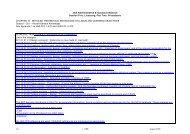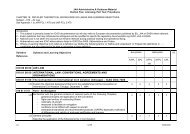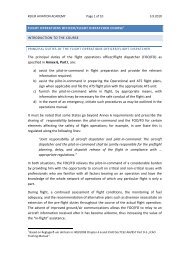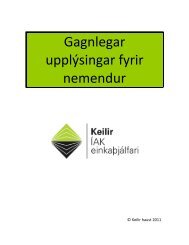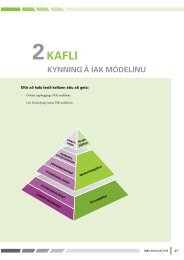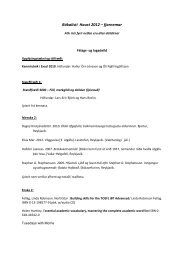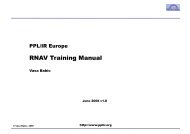Flight Academy â Cabin Crew - Keilir
Flight Academy â Cabin Crew - Keilir
Flight Academy â Cabin Crew - Keilir
You also want an ePaper? Increase the reach of your titles
YUMPU automatically turns print PDFs into web optimized ePapers that Google loves.
<strong>Keilir</strong> Aviation <strong>Academy</strong> – <strong>Cabin</strong> <strong>Crew</strong>Initial Training SyllabusInitial trainingCourse Description Objective CreditsWOA103 The World of AviationIntroduction to Aviation including terminology and role of Authority.Aviation Terminology1. Phonetic Alphabet2. Terminology & Abbreviations3. Time Zone / 24 hours clock4. Airport and City CodesAeronautical Law1. ICAA/JAA/IATA/FAA2. <strong>Cabin</strong> <strong>Crew</strong> Member training requirements3. Passenger rights & transportation law4. Rights to compensation5. Quality Assurance6. Manuals, revisions & distribution7. Duty Time LimitationsHealth and safety related issues are touched upon both during onboardduties as well as during pre-flight resting. All safety aspect taken intoconsideration regarding safety of <strong>Cabin</strong> <strong>Crew</strong> Members in the workingenvironment;1. Safety onboard2. Personal Safety3. Eating habits4. Health and Wellness5. Eating habitsStudents are capable of understanding theterminology used in manuals and aviationhandbooks. Receive general knowledge andunderstanding of the aviation industryincluding regulations and requirements.Have the knowledge and ability to follow upon duty limitations rest requirement inaccordance with EU-OPS minimumrequirements.Students learn to understand the importanceof personal health and self vigilance.Importance of sleep/rest between duty timesand personal responsibilities for own health &safety.3September 2010 1
WOA102 is covering the following EU requirements:EU OPS 1 Subpart O Appendix 1.1005 (g),1-4,6.8,Discipline and responsibilities. It shall be ensured that the training includes:(g) 1.The importance of cabin crew performing their duties in accordance with the operations manual(g) 2.Continuing competence and fitness to operate as a cabin crew member with special regard to flight and duty time limitations and restrequirements(g) 3.An awareness of the aviation regulations relating to cabin crew and the role of the Civil Aviation Authority(g) 4. General knowledge of relevant aviation terminology, theory of flight, passenger distribution, meteorology and areas of operation(g) 6. The importance of ensuring that relevant documents and manuals are kept up-to date(g) 8.The importance of safety duties and responsibilities and the need to respond promptly and effectively to emergency situations.TOF102 Theory of <strong>Flight</strong>Basic features of the aircraft are explained these include theory ofweight, lift, thrust and drag.Introduction to Aerodynamics & Meteorology:1. Effects of weather on operation and flight2. Cloud formations and types3. Turbulence4. Mass & balance5. Cold Weather OperationStudents gain a general understanding ofaircraft features and terminology as well as anintroduction to effects of weather on flight.2TOF102 is covering the following EU requirements:JAR OPS 1 Subpart O Appendix 1.1005 g, 4,9Discipline and responsibilities. It shall be ensured that the training includes:(g) 4. General knowledge of relevant aviation terminology, theory of flight, passenger distribution, meteorology and areas of operation(g) 9. Awareness of the effects of surface contamination and the need to inform the flight crew of any observed surface contaminationFIS102 Fire and SmokeBasic introduction to the elements of fire as well as classifications andgeneral reaction.Subjects covered;September 2010 2Basic understanding of fire fightingprocedures. First reaction and classification.2
1. Nature and behavior of fire2. Classification of fires3. Precautions & vigilance of high risk areas4. Type of extinguishing agents5. Flammable materials6. General knowledge when dealing with fire7. Communication with <strong>Flight</strong> crew and other <strong>Cabin</strong> <strong>Crew</strong>8. Introduction to the fire department and their role on groundThe course should prepare students for202FIS where practical training is emphasizedon as well as specific airline relatedprocedures are covered in dept.FIS102 is covering the following EU requirements:EU OPS 1 Subpart O Appendix 1.1005 (a) 1-5Fire and Smoke Training. It shall be ensured that the training includes:(a) 1.Emphasis on the responsibility of cabin crew to deal promptly with emergencies involving fire and smoke and, in particular, emphasis onthe importance of identifying the actual source of the fire(a)2.The importance of informing the flight crew immediately, as well as the specific actions necessary for co-ordination and assistance, when fireor smoke is discovered(a) 3.The necessity for frequent checking of potential fire-risk areas including toilets, and the associated smoke detectors(a) 4.The classification of fires and the appropriate type of extinguishing agents and procedures for particular fire situations, the techniques ofapplication of extinguishing agents, the consequences of misapplication, and of use in a confined space(a) 5.The general procedures of ground based emergency services at aerodromes.CDP102 Conflict Management –Disruptive passengers<strong>Cabin</strong> <strong>Crew</strong> Members approach & strategy when dealing with disruptivepassengers. Student learn how to react when dealing with unrulypassengers and get a better understanding in what reaction can diffuseand/or elevate the situation.Covering the following;1. Disruptive behavior and Unruly passengers2. Active listening and problem resolution3. Diffusion techniques4. Self-defense5. Restraining6. Paperwork and reporting proceduresCDP102 is covering the following EU requirements:September 2010 3Students understand the importance ofstrategy when dealing with unruly passengers.Students learn how to diffuse disruptivebehavior as well as restraining techniques2
EU OPS 1 Subpart O Appendix 1.1005 (e), 1Passenger handling. It shall be ensured that the training includes:(e) 1.Advice on the recognition and management of passengers who are, or become, intoxicated with alcohol or are under the influence of drugsor are aggressiveSET103 Safety and Emergency Training<strong>Cabin</strong> crew responsibilities and in case of Pilot incapacitation.Appropriate reaction in case of rapid decompression.Diversion and emergency landing.Duties and responsibilities in an emergency evacuation, crowd control,initiation of evacuation by cabin crew.Survival techniques in different circumstances. Strategy and use ofresources is emphasized depending on environment. Leadership andcrowd control when in high stress atmosphere.Basic survival in;1. Polar2. Desert3. Jungle4. Sea3SET102 is covering the following EU requirements:EU OPS 1 Subpart O Appendix 1.1005 (c) (e) (g)Passenger handling. It shall be ensured that the training includes:(e) Methods used to motivate passengers and the crowd control necessary to expedite an aircraft evacuationDiscipline and responsibilities. It shall be ensured that the training includes:(g) 7.The importance of identifying when cabin crew members have the authority and responsibility to initiate an evacuation and other emergencyprocedures(g) 8. The importance of safety duties and responsibilities and the need to respond promptly and effectively to emergency situations.Survival Training(c)Survival Training shall be appropriate to the areas of operation, (e.g. polar, desert, jungle or sea).September 2010 41
WAS101 Water Survival TrainingPractical training in water were student are introduced to rescue andsurvival techniques in a water emergencies.Water survival training includes the actual donning and use of personalflotation equipment in water by each cabin crew member. Before firstoperating on an aeroplane fitted with life-raft or other similarequipment, training must be given on the use of this equipment, as wellas actual practice in water.Students get hands on training in watersurvival technique were emphasizes is placedon;Rescue swimmingLife rafts and survival equipment locationRescuing of passengers from waterErection of canopyImportance of CRM & LeadershipWAS101 is covering the following EU requirements:EU OPS 1 Subpart O Appendix 1.1005 (b)Water Survival Training.It shall be ensured that water survival training includes the actual donning and use of personal flotation equipment in water by each student. Beforefirst operating on an aircraft fitted with life-rafts or other similar equipment, training must be given on the use of this equipment, as well as actualpractice in water.AID103 First AidCovers the practical skills required for onboard first aid emergencies1. First aid associated with survival training and appropriate hygiene2. Physiological effects on flying with particular emphasis on oxygenrequirements and Hypoxia3. Medical emergencies in aviation4. Basic first aid and survival careDetailed knowledge of Medical & first aid kit contents including companyprocedures and policies will be specified in AID206 which is a continuous coursefrom AID106.Student gain confidence, knowledge and skillnecessary to prevent, recognize, and providebasic care for injuries and sudden illnesses.3AID103 is covering the following EU requirements:EU OPS 1 Subpart O Appendix 1.1005 (d), 1-3Medical aspects and First Aid Training. It shall be ensured that the training includes:(d) 1. Instruction on medical aspects and first aid, first aid kits, emergency medical kits, their contents and emergency medical equipment(d) 2.First aid associated with survival training and appropriate hygiene(d) 3.The physiological effects of flying and with particular emphasis on hypoxiaSeptember 2010 5
Appendix 3 to EU-OPS 1.1005 / 1.1010 / 1.1015Medical aspects and First Aid Training. It shall be ensured that the training includes:(a) Medical aspects and first aid training shall include the following subjects:(1) Physiology of flight including oxygen requirements and hypoxia;(2) Medical emergencies in aviation including:(i) Asthma(ii) Choking(iii) Heart attacks(iv) Stress reactions and allergic reactions(v) Shock(vi) Stroke(vii) Epilepsy(viii) Diabetes(ix) Air sickness(x) Hyperventilation(xi) Gastro-intestinal disturbances(xii) Emergency childbirth(3) Practical cardio - pulmonary resuscitation by each cabin crew member having regard to the aeroplane environment and using a specificallydesigned dummy(4) Basic first aid and survival training including care of:(i) The unconscious(ii) Burns(iii) Wounds(iv) Fractures and soft tissue injuries(5) Travel health and hygiene including:(i)The risk of contact with infectious diseases especially when operating into tropical and sub-tropical areas. Reporting of infectiousdiseases, protection from infection and avoidance of water-borne and food-borne illness. Training shall include the means to reduce suchrisks(ii) Hygiene on board(iii) Death on board(iv) Handling of clinical waste(v) Aircraft disinfection(vi) Alertness management, physiological effects of fatigue, sleep physiology, circadian rhythm and time zone changes(6) The use of appropriate aeroplane equipment including first aid kits, emergency medical kits, first aid oxygen and emergency medicalequipment.September 2010 6
SOT102 Standard Operating TrainingPassenger Handling:Detailed instructions on how to control the cabin and passengers duringa normal operation. Students learn the difference in passengercategories as well as baggage stowage and other safety related dutiescabin crew require taking care of.Introduction to SOP:1. General preflight, during flight and post flight duties2. Pre flight briefing & post flight briefing (de-briefing)3. Custom regulations4. Paperwork5. Special categories of passengersCommunication:During training emphasis is placed on the importance of effectivecommunication between flight crew, cabin crew and passengers. Thisincludes technique, common language and terminology.General communication and first impression, professionalism & handlingof passengers in everyday situation.Interaction in multi cultural environmentAcknowledgment of regulations andprecautionsStudents learn the importance of goodcommunication within the working team andvital steps in eliminating rising errors.The importance of professionalism andcourtesy when dealing with passengers in aday to day working environment1. Effective Communication2. Communication techniques3. Active Listening4. Respect and discipline while communicating with others5. Non verbal communication & signals6. Pre-flight briefing / De-briefingsSOT102 is covering the following EU requirements:EU OPS 1 Subpart O Appendix 1.1005 (e) 2-6, (g) & (h), 5, 7 & 8Passenger handling. It shall be ensured that the training includes:(e)2.Regulations covering the safe stowage of cabin baggage (including cabin service items) and the risk of it becoming a hazard tooccupants of the cabin or otherwise obstructing or damaging safety equipment or aeroplane exitsSeptember 2010 7
(e) 3.The importance of correct seat allocation. Particular emphasis shall be given on the seating of disabled passengers, and the necessity ofseating able-bodied passengers adjacent to unsupervised exits(e) 4. Duties to be undertaken in the event of encountering turbulence including securing the cabin(e) 5.Precautions to be taken when live animals are carried in the cabinCommunication.(f)It shall be ensured that, during training, emphasis is placed on the importance of effective communication between cabin crew and flight crewincluding technique, common language and terminology.Discipline and responsibilities. It shall be ensured that the training includes:(g) 5.Pre-flight briefing of the cabin crew and the provision of necessary safety information with regard to their specific dutiesCRM103 <strong>Crew</strong> Resource ManagementInitial Introductory CRM Course:Students gain understanding of the CRM theory and learn theimportance of using it. The importance of good communication andcoordination as well as error chain, management of stress factors,fatigue and vigilance are emphasized on.CRM103 is covering the following EU requirements:EU OPS 1.1005 (i) Appendix 2, Table 1, Column (b)Students understand the importance ofeffective CRM within team. They learn torecognize when CRM is lacking and how toreact in such environment.3General Principles – In depthColumn (b)1. Human factors in aviation & General instructions on CRM principles and objectivesColumn (b)2. Human performance and limitationsFrom the perspective of the individual cabin crew member – In depthColumn (b)3. Personality awareness, human error and reliability, attitudes and behaviors, self-assessmentColumn (b)4. Stress and stress managementColumn (b)5. Fatigue and vigilanceColumn (b)6. AssertivenessColumn (b)7. Situation awareness, information acquisition and processing.September 2010 8
SEC103 Security<strong>Cabin</strong> <strong>Crew</strong> Members learn how to take appropriate preventive actionsas well as to minimize the consequences of such events should theyoccur.Main topics covered during training are:1. Unlawful interference including Hijacking2. Bomb Threat3. Sabotage Threat4. Other threats to passengers, crew and aircraftStudent learn how to deal with different typesof threats to passengers and crew as well ashow to maximize security by use ofpreventive actions 3SEC103 is covering the following EU requirements:EU OPS 1.1005 (e) 8 & Subpart S EU-OPS 1.1235Passenger handling. It shall be ensured that the training includes:(e) 8.Security procedures, including the provisions of Subpart SSubpart S EU-OPS 1.1235 Security requirements:It shall be ensured that all appropriate personnel are familiar, and comply, with the relevant requirements of the national security programmes of theState of the operator.EU-OPS 1.1240 Training programmes:An operator shall establish, maintain and conduct approved training programmes which enable the operator’s crew members to take appropriateaction to prevent acts of unlawful interference, such as sabotage or unlawful seizure of aeroplanes and to minimise the consequences of such events,should they occur. The training programme shall be compatible with the National Aviation Security programme. Individual crew member shall haveknowledge and competence of all relevant elements of the training programme.DAG102 Dangerous GoodsProcedures & limitations of Dangerous Goods articles are viewed alongwith the labeling & handling of such goods. Emergency procedures whendealing with incidents/accidents that involve dangerous goods spillageare thoroughly laid out.1. General philosophy2. Limitations on Dangerous Goods in air transport3. Package marking and labelingStudents become familiar with dangerousgoods articles, labeling and restrictions tocarriage of goods 2September 2010 9
4. Dangerous Goods in passengers baggage5. Emergency procedures.DAG102 is covering the following EU requirements:EU OPS 1.1005 (f) 7 & Subpart R EU-OPS 1.1220(e) 7. Dangerous Goods training as prescribed in Subpart RSubpart REU–OPS 1.1220 Training programmes:a Establish and maintain staff training programmes, as required by the Technical Instructions, which shall be approved by the authority.b Ensure that staff receives training in the requirements commensurate with their responsibilities.c Ensure that training is provided or verified upon the employment of a person in a position involving the transport of dangerous goods byair.d Ensure that all staff who receives training undertakes a test to verify understanding of their responsibilities.e Ensure that all staff who requires dangerous goods training receives recurrent training at intervals of not longer than 2 years.f Ensure that records of dangerous goods training are maintained for all staff as required by the Technical Instructions.EU-OPS 1.225Dangerous goods incidents and accident reportsGRO101 GroomingEmphasize is placed on a positive personal image which generatesprofessionalism and respect when in uniform or in everyday life.Subjects covered;1. Hair2. Makeup3. Nails/Hands4. HygieneECO103 English CommunicationEmphasis on spoken language and basic communication when dealingwith passengers. Student participate in interactive exercises were theirvocabulary is extended as well as their comfort level.Students learn how to keep a clean andprofessional look throughout their duty.Basic rules in grooming and personal hygieneare also studied.Students gain a comprehensive experience ofcommunicating in English13September 2010 10
ECO 103 covering the following EU-OPS requirements:EU OPS 1.1005 (f)DCO103 Danish CommunicationEmphasis on spoken language and basic communication when dealingwith passengers. Student participate in interactive exercises were theirvocabulary is extended as well as their comfort level.Students gain a comprehensive experience ofcommunicating in Danish 3September 2010 11
CIT101 Computer & Information technologyIntroduction to the PC environment and computer programs such asWord, Excel, PowerPoint and Internet Explorer. Training in independentstudy techniques and planning of personal projects.Topics covered are;1. <strong>Keilir</strong> Web page2. Email, chat, search engines3. My Computer, set up of hard drive4. Text processing5. Essay preparationStudent gain basic computer skills andassistance with organizing there personalstudies.1CSS103 Customer Service & SalesInstruction to onboard service1. First Class Service2. Business Class Service3. Economy Class Service4. <strong>Flight</strong> Deck Service and ProtocolStudents learn different approach to eachservice class as well as gain an understandingin customer careSales TechniqueThe course aims to provide students with all the skills necessary to dealwith a general selling situation. Students are introduced to salestechniques with the focus on;1. Knowledge2. People skills3. Right attitude4. Identifying buying signals, verbal and non verbalStudents develop understanding andconfidence in correct sales techniques3Initial ExamAn operator shall ensure that each cabin crew member successfully completesinitial training. The training program must be approved by the Authority, inaccordance with Appendix 1 to EU-OPS 1.1005, and the checking prescribed inEU-OPS 1.1025 before undertaking conversion training.September 2010 12
EU-OPS 1.1025 Checking(a) An operator shall ensure that during or following completion of the training required by EU-OPS 1.1005, each cabin crew member undergoesa check covering the training received in order to verify his proficiency in carrying out normal and emergency safety duties. These checksmust be performed by personnel acceptable to the Authority.(b) An operator shall ensure that each cabin crew member undergoes checks as follows:(b)1 Initial training. The items listed in Appendix 1 to EU–OPS 1.1005September 2010 13






